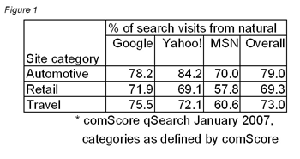How to Champion Natural Search Optimization
 In my previous column, I discussed InterActiveCorp (IAC) CEO Barry Diller, who helped his company spur significant visitor growth by recognizing an opportunity for its content-rich Citysearch online guides to capitalize on natural search and allocating search-engine experts to act on the opportunity.
In my previous column, I discussed InterActiveCorp (IAC) CEO Barry Diller, who helped his company spur significant visitor growth by recognizing an opportunity for its content-rich Citysearch online guides to capitalize on natural search and allocating search-engine experts to act on the opportunity.
One reader asked:
How can a CEO/CMO with no particular experience in natural search optimization, who would be a willing champion given the opportunity, refocus or restructure an organization to make that happen? Are there tools, resources, etc. that allow an enthusiastic champion to properly deploy this enthusiasm into tangible results?
This struck me as a question other executives might share. Because most search visits in the commercial categories that most heavily use paid search actually originate from natural search (see the chart below), a closer look is well worth the effort.

Consider this two-step approach to tackling this opportunity: 1. Diagnosing the problem. 2. Empowering success.
Diagnosing the problem
Get your own high-level overview of the situation in a few simple steps. First, ask your site administrator how many public pages exist on your site. Then search Google.com and Yahoo.com for “site:YOURSITE.COM”. A Pottery Barn executive, for example, would enter “site:PotteryBarn.com”. This command tells the search engines to list every page of your site for which they have a record.
Now compare the number of results reported by the engine to the number of pages your site actually has. Any significant disparity, positive or negative, indicates that you have technical or site architecture hurdles keeping you from natural search optimization (NSO) success. Too few pages indexed means the search engines are not aware of your pages and therefore can’t show them to searchers. Too many pages indexed means you are serving multiple versions of the same page to engines, diluting each page’s ability to show up for relevant queries.
The next check you can run yourself is to search for important keywords. What words are synonymous with your brand or offerings? What is your most popular product? Enter these in Google, Yahoo!, and MSN. Does your site show up in the first three to five listings, where the bulk of natural-search clicks occur? You can also use the “site” command above (“site:yoursite.com product”) with these keywords to see your best page related to each keyword.
Finally, look at the content of the search result listings that you find for your site. If that is the only impression a searcher is getting of your offerings, does it meet your standards? Is your brand positioning correct? Is the listing accurate and up-to-date? Remember that searchers use these listings to form opinions about products and services as they search. Are they likely to form a good opinion based on what you’re seeing?
NSO can full address issues in each of these areas. A much deeper analysis, though, will be necessary to identify root causes and solutions. A reputable search marketing agency can diagnose the fundamental NSO problems, digging deeper and providing actionable insights.
Empowering success
Once you understand the hurdles preventing NSO success, talk to your marketing or search marketing teams to determine how you can help. Whatever the past reasons for a lack of NSO success, assume a clean slate.
Are they aware of the NSO problem? Often the core problems are known by someone internally who has been unable to overcome organizational or technical hurdles to achieve results. Facilitating an open dialogue here is key.
If your teams are aware of the problem, have they created a business case that justifies a solution? Frequently the core problem with natural search is not awareness but understanding the value of solving the problem. The business case needs to address the untapped potential for visibility in search engines and the resulting traffic to your site.
If a plan exists, what stands in the marketing team’s way? Perhaps IT doesn’t have the time or resources available to help. If this is the case, it usually means your company has not prioritized NSO changes among your Website’s other technical needs. Fundamentally NSO success will dictate two technical requirements: first, an architecture allowing the search engines to access all relevant content, and second, content management tools that enable search marketers to modify, test, and further refine content. Solutions are also available that “outsource” these two fundamental capabilities, allowing marketers to work around internal resource issues or problematic site architecture.
C-suite executives desiring NSO success can contribute to the cause in more ways than they often realize by taking simple steps to diagnose problems, identify solutions, isolate roadblocks, and empower success.
Cam Balzer is vice president of strategic planning at Performics, the Chicago-based performance marketing division of DoubleClick, and a monthly contributor to CHIEF MARKETER. Contact him at [email protected].
Other articles by Cam Balzer:
Search in 2007: The Year of Integration
Search Engine Marketing Does More Than Ever This Holiday Season
Quantifying Online Search’s Impact on Offline Demand
Listen to the Data: Using Search to Understand Your Market
Click Fraud: Three Important Considerations





























